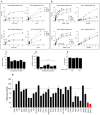Discovery and Design of Novel Small Molecule GSK-3 Inhibitors Targeting the Substrate Binding Site
- PMID: 33218072
- PMCID: PMC7698860
- DOI: 10.3390/ijms21228709
Discovery and Design of Novel Small Molecule GSK-3 Inhibitors Targeting the Substrate Binding Site
Abstract
The serine/threonine kinase, GSK-3, is a promising drug discovery target for treating multiple pathological disorders. Most GSK-3 inhibitors that were developed function as ATP competitive inhibitors, with typical limitations in specificity, safety and drug-induced resistance. In contrast, substrate competitive inhibitors (SCIs), are considered highly selective, and more suitable for clinical practice. The development of SCIs has been largely neglected in the past because the ambiguous, undefined nature of the substrate-binding site makes them difficult to design. In this study, we used our previously described structural models of GSK-3 bound to SCI peptides, to design a pharmacophore model and to virtually screen the "drug-like" Zinc database (~6.3 million compounds). We identified leading hits that interact with critical binding elements in the GSK-3 substrate binding site and are chemically distinct from known GSK-3 inhibitors. Accordingly, novel GSK-3 SCI compounds were designed and synthesized with IC50 values of~1-4 μM. Biological activity of the SCI compound was confirmed in cells and in primary neurons that showed increased β-catenin levels and reduced tau phosphorylation in response to compound treatment. We have generated a new type of small molecule GSK-3 inhibitors and propose to use this strategy to further develop SCIs for other protein kinases.
Keywords: GSK-3; peptides; pharmacophore; small molecules; substrate competitive inhibitors; virtual screening.
Conflict of interest statement
The authors declare no conflict of interest.
Figures







Similar articles
-
Identification of novel scaffold of benzothiazepinones as non-ATP competitive glycogen synthase kinase-3β inhibitors through virtual screening.Bioorg Med Chem Lett. 2012 Dec 1;22(23):7232-6. doi: 10.1016/j.bmcl.2012.09.043. Epub 2012 Sep 23. Bioorg Med Chem Lett. 2012. PMID: 23099099
-
Novel benzothiazinones (BTOs) as allosteric modulator or substrate competitive inhibitor of glycogen synthase kinase 3β (GSK-3β) with cellular activity of promoting glucose uptake.Bioorg Med Chem Lett. 2014 Dec 15;24(24):5639-5643. doi: 10.1016/j.bmcl.2014.10.078. Epub 2014 Oct 30. Bioorg Med Chem Lett. 2014. PMID: 25467150
-
Identification and in vitro evaluation of new leads as selective and competitive glycogen synthase kinase-3β inhibitors through ligand and structure based drug design.J Mol Graph Model. 2014 Sep;53:31-47. doi: 10.1016/j.jmgm.2014.06.013. Epub 2014 Jul 12. J Mol Graph Model. 2014. PMID: 25064440
-
Substrate competitive GSK-3 inhibitors - strategy and implications.Biochim Biophys Acta. 2010 Mar;1804(3):598-603. doi: 10.1016/j.bbapap.2009.09.010. Epub 2009 Sep 18. Biochim Biophys Acta. 2010. PMID: 19770076 Review.
-
Exploiting substrate recognition for selective inhibition of protein kinases.Curr Pharm Des. 2012;18(20):2914-20. doi: 10.2174/138161212800672741. Curr Pharm Des. 2012. PMID: 22571660 Review.
Cited by
-
GSK-3 and Tau: A Key Duet in Alzheimer's Disease.Cells. 2021 Mar 24;10(4):721. doi: 10.3390/cells10040721. Cells. 2021. PMID: 33804962 Free PMC article. Review.
-
Recent Advances in Kinase Drug Discovery Part I: The Editors' Take.Int J Mol Sci. 2021 Jul 15;22(14):7560. doi: 10.3390/ijms22147560. Int J Mol Sci. 2021. PMID: 34299180 Free PMC article.
-
Recent advances in Alzheimer's disease: Mechanisms, clinical trials and new drug development strategies.Signal Transduct Target Ther. 2024 Aug 23;9(1):211. doi: 10.1038/s41392-024-01911-3. Signal Transduct Target Ther. 2024. PMID: 39174535 Free PMC article. Review.
-
GSK-3β, FYN, and DYRK1A: Master Regulators in Neurodegenerative Pathways.Int J Mol Sci. 2021 Aug 23;22(16):9098. doi: 10.3390/ijms22169098. Int J Mol Sci. 2021. PMID: 34445804 Free PMC article. Review.
-
Targeting the Wnt/β-Catenin Signaling Pathway as a Potential Therapeutic Strategy in Renal Tubulointerstitial Fibrosis.Front Pharmacol. 2021 Aug 16;12:719880. doi: 10.3389/fphar.2021.719880. eCollection 2021. Front Pharmacol. 2021. PMID: 34483931 Free PMC article. Review.
References
MeSH terms
Substances
Grants and funding
LinkOut - more resources
Full Text Sources
Other Literature Sources
Molecular Biology Databases
Miscellaneous

